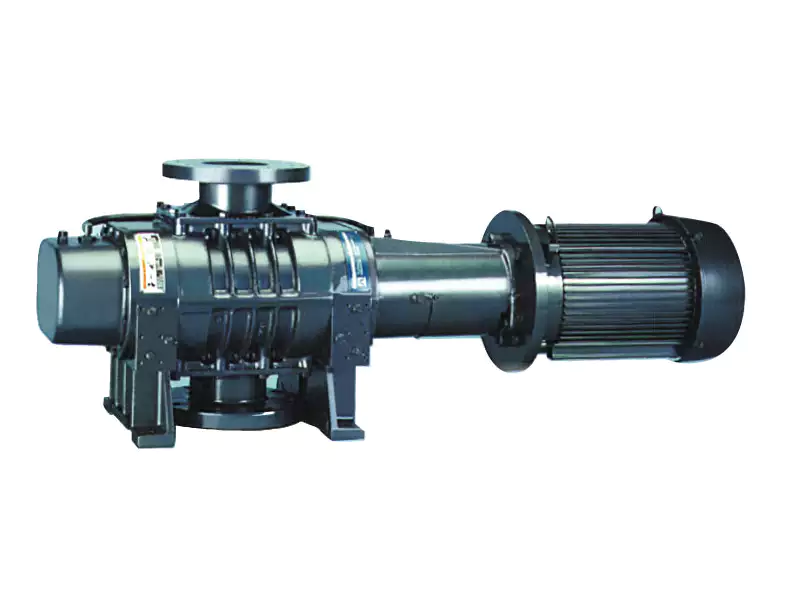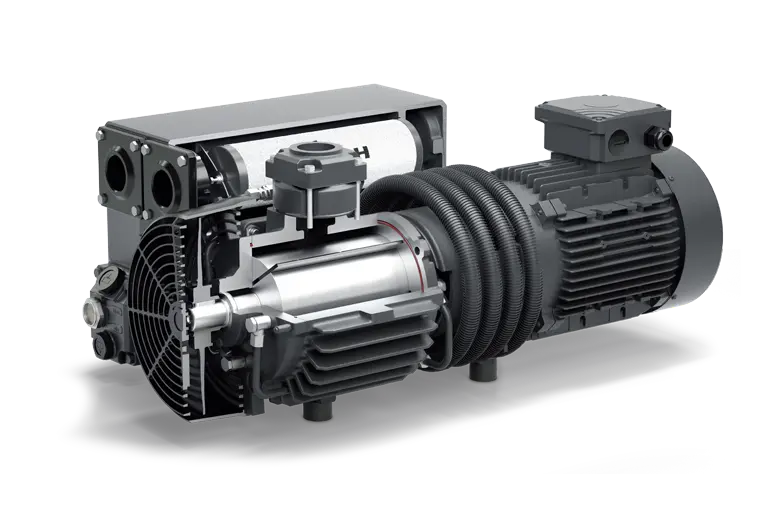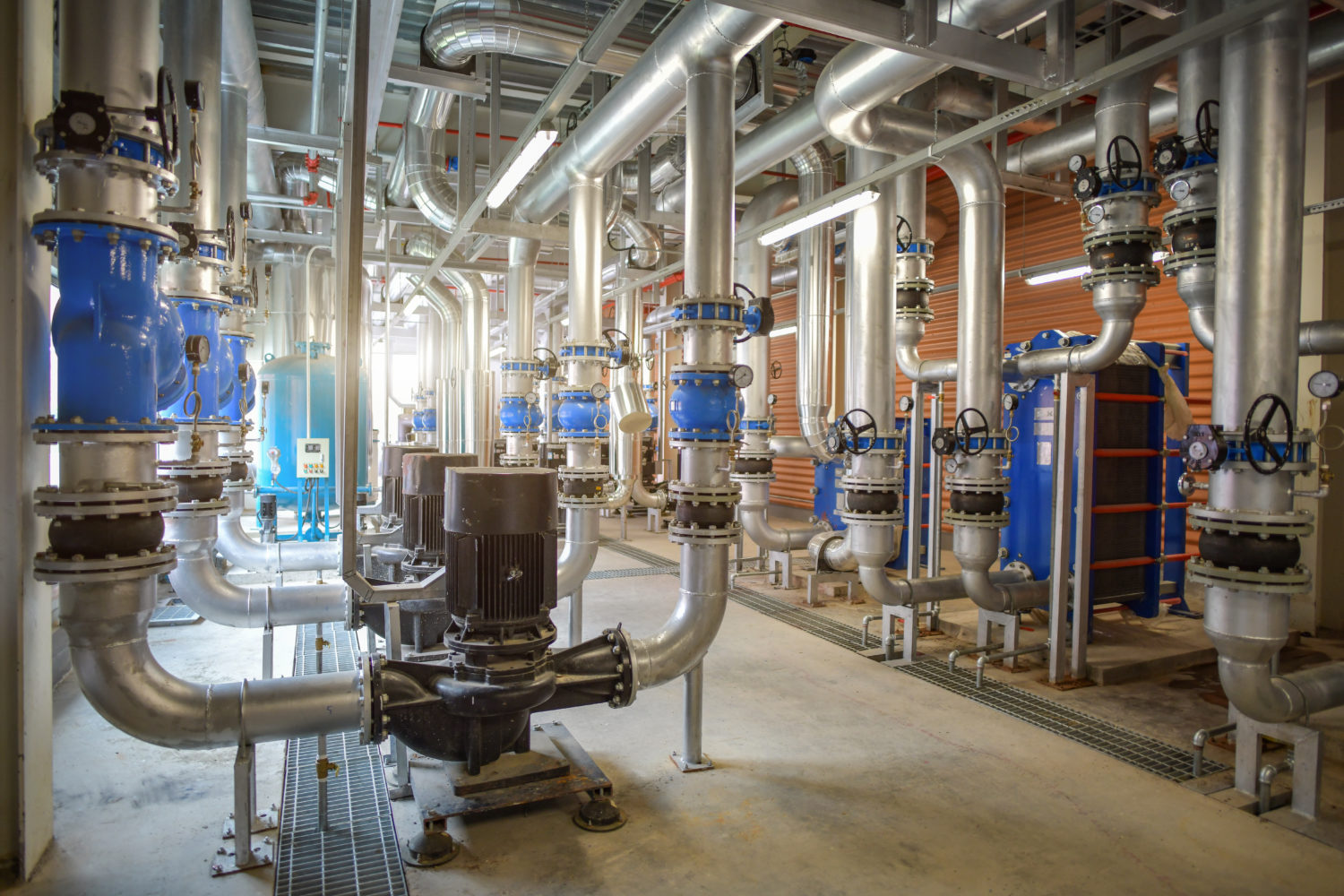Описание товара
Описание товара
Rotary vane vacuum pump mainly consists of pump body, rotor, rotary vane, end cap, oil tank and so on. A rotor with 3 vanes is mounted eccentrically in a cylindrical housing, the 3 vanes slide in the rotor slots. When rotating, the centrifugal force keeps the vanes in contact with the housing and the rotation drives the rotor to slide along the housing.
| 1.Exhaust porti nterface | 2.Exhaust filter | 3.Suction valve |
| 4.Oil level gauge | 5.Drain valve | 6.Filler plug |
| 7.Exhaust valve | 8.Blade | 9.Rotor |
| 10.Tank | 11.Axial fan | 12.Motor |
| 13.Oil filter | 14.Suction port interface | 15.Air ballast valve |
| 16.Radiator tube | 17.Return valve |
Working principle
The diagram below shows the structure of the pump. When the rotor rotates, the vanes, the housing and the 2 end caps form three chambers, every turn, the volume of each chamber increases or decreases due to the sliding of the vanes, completing the suction and discharge process.
Main features
- Able to work continuously for a long time under the inlet pressure of 5×104Pa.
- Low noise, low vibration, foot bolts is not required.
- Exhaust filter in the pump effectively separates the oil in the gas to avoid pollution of the environment.
- Directly driven by motor.
- Compact structure, light weight, air-cooled.
- Easy to operate, install and maintain.
Приложения
The rotary vane vacuum pump is suitable for the applications where the requirement of vacuum is not high and the operation is reliable and maintenance is convenient. It is commonly used in vacuum packaging of various foodstuffs, vacuum forming of rubber and plastic industry, paper transmission of printing industry, vacuum impregnation and leakage prevention of various castings, vacuum fixture, vacuum drying, vacuum filtration, and hospital surgery.
Product Parameters
| Model | Nominal pumping speed(50Hz) m³/h |
Ultimate pressure ≤Pa |
Ultimate pressure with Gas Ballast valve on ≤Pa | Nominal motor rating (50Hz) kw | Nominal motor speed (50Hz) RPM | Water vapour capacity kg/h |
Noise level db(A) | Oil capacity L |
Working Temperature ºC |
Suction Connection size inch |
Discharge Connection size inch |
Weight kg |
| XD-571 | 10 | 200 | 0.37 | 2800 | 0.4 | 62 | 0.5 | 77 | G1/2″ | G1/2″ | 16 | |
| XD-571 | 20 | 200 | 0.75 | 2880 | 0.4 | 63 | 0.5 | 77 | G1/2″ | G1/2″ | 18 | |
| XD-571A | 20 | 200 | 0.75 | 2880 | 0.4 | 63 | 0.5 | 77 | G1/2″ | G1/2″ | 18 | |
| XD-571C | 20 | 200 | 0.9 | 2880 | 0.4 | 65 | 0.5 | 79 | G3/4″ | G3/4″ | 20 | |
| XD-571 | 25 | 200 | 0.75 | 2880 | 0.4 | 65 | 0.5 | 79 | G3/4″ | G3/4″ | 20 | |
| XD-040C | 40 | 50 | 200 | 1.1 | 1500 | 0.6 | 64 | 1.25 | 76 | G1 1/4″ | G1 1/4″ | 48 |
| XD-063C | 63 | 50 | 200 | 1.5/2.2 | 1500 | 1 | 65 | 2 | 79 | G1 1/4″ | G1 1/4″ | 58 |
| XD-063D | 63 | 50 | 200 | 1.5 | 1500 | 0.6 | 65 | 1.5 | 79 | G1 1/4″ | G1 1/4″ | 49 |
| XD-100C | 100 | 50 | 200 | 2.2/3 | 1500 | 1.5 | 66 | 2 | 79 | G1 1/4″ | G1 1/4″ | 72 |
| XD-160C | 160 | 50 | 200 | 4 | 1500 | 2.5 | 71 | 5 | 70 | G2″ | G2″ | 158 |
| XD-202C | 200 | 50 | 200 | 4 | 1500 | 4 | 73 | 5 | 70 | G2″ | G2″ | 158 |
| XD-250C | 250 | 50 | 200 | 5.5 | 1500 | 4.5 | 73 | 7 | 73 | G2″ | G2″ | 195 |
| XD-302C | 300 | 50 | 200 | 5.5/7.5 | 1500 | 5 | 75 | 7 | 75 | G2″ | G2″ | 211 |
Dimensional drawing
Our factory
ЧАСТО ЗАДАВАЕМЫЕ ВОПРОСЫ
Q: What information should I offer for an inquiry?
A: You can inquire based on the model directly, but it is always recommended that you contact us so that we can help you to check if the pump is the most appropriate for your application.
Q: Can you make a customized vacuum pump?
A: Yes, we can do some special designs to meet customer applications. Such as customized sealing systems, speical surface treatment can be applied for roots vacuum pump and screw vacuum pump. Please contact us if you have special requirements.
Q: I have problems with our vacuum pumps or vacuum systems, can you offer some help?
A: We have application and design engineers with more than 30 years of experience in vacuum applications in different industries and help a lot of customers resolve their problems, such as leakage issues, energy-saving solutions, more environment-friendly vacuum systems, etc. Please contact us and we’ll be very happy if we can offer any help to your vacuum system.
Q: Can you design and make customized vacuum systems?
A: Yes, we are good for this.
Q: What is your MOQ?
A: 1 piece or 1 set.
Q: How about your delivery time?
A: 5-10 working days for the standard vacuum pump if the quantity is below 20 pieces, 20-30 working days for the conventional vacuum system with less than 5 sets. For more quantity or special requirements, please contact us to check the lead time.
Q: What are your payment terms?
A: By T/T, 50% advance payment/deposit and 50% paid before shipment.
Q: How about the warranty?
A: We offer 1-year warranty (except for the wearing parts).
Q: How about the service?
A: We offer remote video technical support. We can send the service engineer to the site for some special requirements.
| Послепродажное обслуживание: | Online Video Instruction |
|---|---|
| Гарантия: | 1 Year |
| Nominal Pumping Speed(50Hz): | 300 M3/H |
| Ultimate Pressure(W/O Gas Ballast Valve): | 0.5 Hpa |
| Nominal Motor Rating(50Hz): | 5.5/7.5kw |
| Nominal Motor Speed(50Hz): | 1500rpm |

What Is the Role of Vacuum Pumps in Semiconductor Manufacturing?
Vacuum pumps play a critical role in semiconductor manufacturing processes. Here’s a detailed explanation:
Semiconductor manufacturing involves the production of integrated circuits (ICs) and other semiconductor devices used in various electronic applications. Vacuum pumps are used extensively throughout the semiconductor manufacturing process to create and maintain the required vacuum conditions for specific manufacturing steps.
Here are some key roles of vacuum pumps in semiconductor manufacturing:
1. Deposition Processes: Vacuum pumps are used in deposition processes such as physical vapor deposition (PVD) and chemical vapor deposition (CVD). These processes involve depositing thin films of materials onto semiconductor wafers to create various layers and patterns. Vacuum pumps help create a low-pressure environment necessary for precise control of the deposition process, ensuring uniform and high-quality film formation.
2. Etching and Cleaning: Vacuum pumps are utilized in etching and cleaning processes, which involve the removal of specific layers or contaminants from semiconductor wafers. Dry etching techniques, such as plasma etching and reactive ion etching, require a vacuum environment to facilitate the ionization and removal of material. Vacuum pumps aid in creating the necessary low-pressure conditions for efficient etching and cleaning processes.
3. Ion Implantation: Ion implantation is a process used to introduce impurities into specific regions of a semiconductor wafer to modify its electrical properties. Vacuum pumps are used to evacuate the ion implantation chamber, creating the required vacuum environment for accurate and controlled ion beam acceleration and implantation.
4. Wafer Handling and Transfer: Vacuum pumps are employed in wafer handling and transfer systems. These systems utilize vacuum suction to securely hold and manipulate semiconductor wafers during various manufacturing steps, such as loading and unloading from process chambers, robotic transfer between tools, and wafer alignment.
5. Load Lock Systems: Load lock systems are used to transfer semiconductor wafers between atmospheric conditions and the vacuum environment of process chambers. Vacuum pumps are integral components of load lock systems, creating and maintaining the vacuum conditions necessary for wafer transfer while minimizing contamination risks.
6. Metrology and Inspection: Vacuum pumps are utilized in metrology and inspection tools used for characterizing semiconductor devices. These tools, such as scanning electron microscopes (SEMs) and focused ion beam (FIB) systems, often operate in a vacuum environment to enable high-resolution imaging and accurate analysis of semiconductor structures and defects.
7. Leak Detection: Vacuum pumps are employed in leak detection systems to identify and locate leaks in vacuum chambers, process lines, and other components. These systems rely on vacuum pumps to evacuate the system and then monitor for any pressure rise, indicating the presence of leaks.
8. Cleanroom Environment Control: Semiconductor manufacturing facilities maintain cleanroom environments to prevent contamination during the fabrication process. Vacuum pumps are used in the design and operation of the cleanroom ventilation and filtration systems, helping to maintain the required air cleanliness levels by removing particulates and maintaining controlled air pressure differentials.
Vacuum pumps used in semiconductor manufacturing processes are often specialized to meet the stringent requirements of the industry. They need to provide high vacuum levels, precise control, low contamination levels, and reliability for continuous operation.
Overall, vacuum pumps are indispensable in semiconductor manufacturing, enabling the creation of the necessary vacuum conditions for various processes, ensuring the production of high-quality semiconductor devices.

How Do Vacuum Pumps Impact the Quality of 3D Printing?
Vacuum pumps play a significant role in improving the quality and performance of 3D printing processes. Here’s a detailed explanation:
3D printing, also known as additive manufacturing, is a process of creating three-dimensional objects by depositing successive layers of material. Vacuum pumps are utilized in various aspects of 3D printing to enhance the overall quality, accuracy, and reliability of printed parts. Here are some key ways in which vacuum pumps impact 3D printing:
1. Material Handling and Filtration: Vacuum pumps are used in 3D printing systems to handle and control the flow of materials. They create the necessary suction force to transport powdered materials, such as polymers or metal powders, from storage containers to the printing chamber. Vacuum systems also assist in filtering and removing unwanted particles or impurities from the material, ensuring the purity and consistency of the feedstock. This helps to prevent clogging or contamination issues during the printing process.
2. Build Plate Adhesion: Proper adhesion of the printed object to the build plate is crucial for achieving dimensional accuracy and preventing warping or detachment during the printing process. Vacuum pumps are employed to create a vacuum environment or suction force that securely holds the build plate and ensures firm adhesion between the first layer of the printed object and the build surface. This promotes stability and minimizes the risk of layer shifting or deformation during the printing process.
3. Material Drying: Many 3D printing materials, such as filament or powdered polymers, can absorb moisture from the surrounding environment. Moisture-contaminated materials can lead to poor print quality, reduced mechanical properties, or defects in the printed parts. Vacuum pumps with integrated drying capabilities can be employed to create a low-pressure environment, effectively removing moisture from the materials before they are used in the printing process. This ensures the dryness and quality of the materials, resulting in improved print outcomes.
4. Resin Handling in Stereolithography (SLA): In SLA 3D printing, a liquid resin is selectively cured using light sources to create the desired object. Vacuum pumps are utilized to facilitate the resin handling process. They can be employed to degas or remove air bubbles from the liquid resin, ensuring a smooth and bubble-free flow during material dispensing. This helps to prevent defects and imperfections caused by trapped air or bubbles in the final printed part.
5. Enclosure Pressure Control: Some 3D printing processes, such as selective laser sintering (SLS) or binder jetting, require the printing chamber to be maintained at a specific pressure or controlled atmosphere. Vacuum pumps are used to create a controlled low-pressure or vacuum environment within the printing chamber, enabling precise pressure regulation and maintaining the desired conditions for optimal printing results. This control over the printing environment helps to prevent oxidation, improve material flow, and enhance the quality and consistency of printed parts.
6. Post-Processing and Cleaning: Vacuum pumps can also aid in post-processing steps and cleaning of 3D printed parts. For instance, in processes like support material removal or surface finishing, vacuum systems can assist in the removal of residual support structures or excess powder from printed objects. They can also be employed in vacuum-based cleaning methods, such as vapor smoothing, to achieve smoother surface finishes and enhance the aesthetics of the printed parts.
7. System Maintenance and Filtration: Vacuum pumps used in 3D printing systems require regular maintenance and proper filtration to ensure their efficient and reliable operation. Effective filtration systems within the vacuum pumps help to remove any contaminants or particles generated during printing, preventing their circulation and potential deposition on the printed parts. This helps to maintain the cleanliness of the printing environment and minimize the risk of defects or impurities in the final printed objects.
In summary, vacuum pumps have a significant impact on the quality of 3D printing. They contribute to material handling and filtration, build plate adhesion, material drying, resin handling in SLA, enclosure pressure control, post-processing and cleaning, as well as system maintenance and filtration. By utilizing vacuum pumps in these critical areas, 3D printing processes can achieve improved accuracy, dimensional stability, material quality, and overall print quality.

What Is the Purpose of a Vacuum Pump in an HVAC System?
In an HVAC (Heating, Ventilation, and Air Conditioning) system, a vacuum pump serves a crucial purpose. Here’s a detailed explanation:
The purpose of a vacuum pump in an HVAC system is to remove air and moisture from the refrigerant lines and the system itself. HVAC systems, particularly those that rely on refrigeration, operate under specific pressure and temperature conditions to facilitate the transfer of heat. To ensure optimal performance and efficiency, it is essential to evacuate any non-condensable gases, air, and moisture from the system.
Here are the key reasons why a vacuum pump is used in an HVAC system:
1. Removing Moisture: Moisture can be present within an HVAC system due to various factors, such as system installation, leaks, or improper maintenance. When moisture combines with the refrigerant, it can cause issues like ice formation, reduced system efficiency, and potential damage to system components. A vacuum pump helps remove moisture by creating a low-pressure environment, which causes the moisture to boil and turn into vapor, effectively evacuating it from the system.
2. Eliminating Air and Non-Condensable Gases: Air and non-condensable gases, such as nitrogen or oxygen, can enter an HVAC system during installation, repair, or through leaks. These gases can hinder the refrigeration process, affect heat transfer, and decrease system performance. By using a vacuum pump, technicians can evacuate the air and non-condensable gases, ensuring that the system operates with the designed refrigerant and pressure levels.
3. Preparing for Refrigerant Charging: Prior to charging the HVAC system with refrigerant, it is crucial to create a vacuum to remove any contaminants and ensure the system is clean and ready for optimal refrigerant circulation. By evacuating the system with a vacuum pump, technicians ensure that the refrigerant enters a clean and controlled environment, reducing the risk of system malfunctions and improving overall efficiency.
4. Leak Detection: Vacuum pumps are also used in HVAC systems for leak detection purposes. After evacuating the system, technicians can monitor the pressure to check if it holds steady. A significant drop in pressure indicates the presence of leaks, enabling technicians to identify and repair them before charging the system with refrigerant.
In summary, a vacuum pump plays a vital role in an HVAC system by removing moisture, eliminating air and non-condensable gases, preparing the system for refrigerant charging, and aiding in leak detection. These functions help ensure optimal system performance, energy efficiency, and longevity, while also reducing the risk of system malfunctions and damage.


editor by CX 2023-11-24